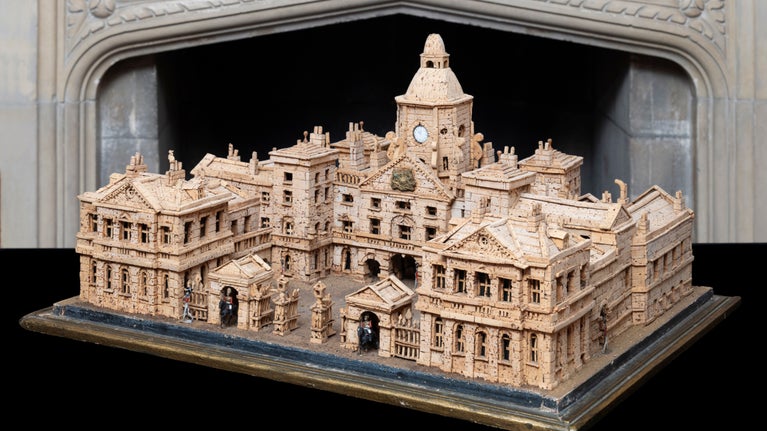
Art and collections
We care for one of the world's largest and most significant collections of art and heritage objects. Explore the highlights, our latest major exhibitions, curatorial research and more.

A shabti (also known as a shawabti or an ushabti) is a generally mummiform figurine of about 5–30cm found in many ancient Egyptian tombs. They are commonly made of blue or green glazed Egyptian faience, but can also consist of stone, wood, clay, metal or glass. The meaning of their name is debated; one possible translation is ‘answerer’, as they were believed to answer their master’s call to work in the afterlife.
Long before the shabti’s occurrence, small human figurines were deposited in tombs. Since the Fourth Dynasty (2613–2494 BC), for instance, the deceased were buried with servant statuettes like bakers and butchers, providing their owners with eternal sustenance.
In the First Intermediate Period (2160–2055 BC), naked statues made of wax and clay, wrapped in linen, were used. However, without corresponding inscriptions, their exact meaning remains unknown.
Only since the Twelfth Dynasty (1985–1773 BC), when their name is documented in texts, can funerary figurines be called shabti. At the beginning, they represented their owners.
According to Egyptian belief, the conservation of the body was essential, as without a functioning body the deceased could not survive in the afterlife. The shabti therefore acted as a surrogate in case their master’s mummy was damaged, guaranteeing his or her eternal life. Because of this intimate relationship, the deceased was only buried with one or two of these figurines.
During the New Kingdom (1550–1069 BC), the role of the shabti changed. The figurine became a mere servant who fulfilled different tasks that would otherwise be imposed on the deceased in the afterlife, such as fieldwork. For this reason, the shabtis are equipped with tools like hoes and seed bags.
The number of servant figurines deposited in tombs increased dramatically at this time. Now the deceased would ideally own 401 shabtis, consisting of 365 worker-shabtis (one per day of the year) and 36 overseer-shabtis (one per Egyptian 10-day week).
After the Ptolemaic Period (332–30 BC), the shabti was no longer produced.
Shabtis are among the most common objects preserved from ancient Egypt. Because of their small size and low weight, early travellers often brought them home as souvenirs. It is therefore unsurprising that there is no Egyptian museum or private collection without at least one shabti.

Kingston Lacy, home of the explorer and Egyptologist William John Bankes (1786–1855), houses a fascinating Egyptian collection that Bankes collected on his extensive travels. Among the many objects of his collection are several shabtis of private as well as royal individuals.
Snowshill Manor houses the collections of architect, artist-craftsman and poet Charles Paget Wade (1883–1956). An avid collector, Wade owned several shabtis dating to different Egyptian time periods.
This article was written by Manon Schutz from the University of Oxford. Manon is interested in the funerary culture of ancient Egypt, especially the use and meaning of beds inside tombs, as well as the multiculturalism observed in the Roman Period of Egypt.

We care for one of the world's largest and most significant collections of art and heritage objects. Explore the highlights, our latest major exhibitions, curatorial research and more.

A hub for multi-disciplinary research projects and research engagement at the University of Oxford
Find out more about our Trusted Source articles, which were created in partnership with the University of Oxford, and explore topics related to the special places in our care.

Taking part in sports is a popular pastime all over the world. From the origins of the Olympics to the evolution of cricket, discover sports through the ages at the collections and places we look after.

From goldwork and gilding to goldsmithing and jewellery making, discover the ways in which gold has been used in the objects in our collections.

We look after the largest collection of tapestries in the UK and one of the largest in the world. Learn more about these status symbols and explore some of the best examples of this craftmanship at the places in our care.

Did you know that the ancient Greeks and Romans loved to grow roses? Discover the roots and symbolism of these much-loved flowers through the objects and art in our care.

The 13,000 oil paintings in our care are nearly all displayed in the houses of their historic owners. Learn about the stories behind a selection of the artworks and their owners.

Discover how the use of paint in the historic interiors of four of the houses in our care reveals evolving fashions, new pigments and residents' wealth and status.

Learn about the ancient treasure that unlocked the secrets of Egyptian hieroglyphs in our podcast episode, 'The needle on the lawn'. You can also find more episodes from series eight, filled with nature and history.
